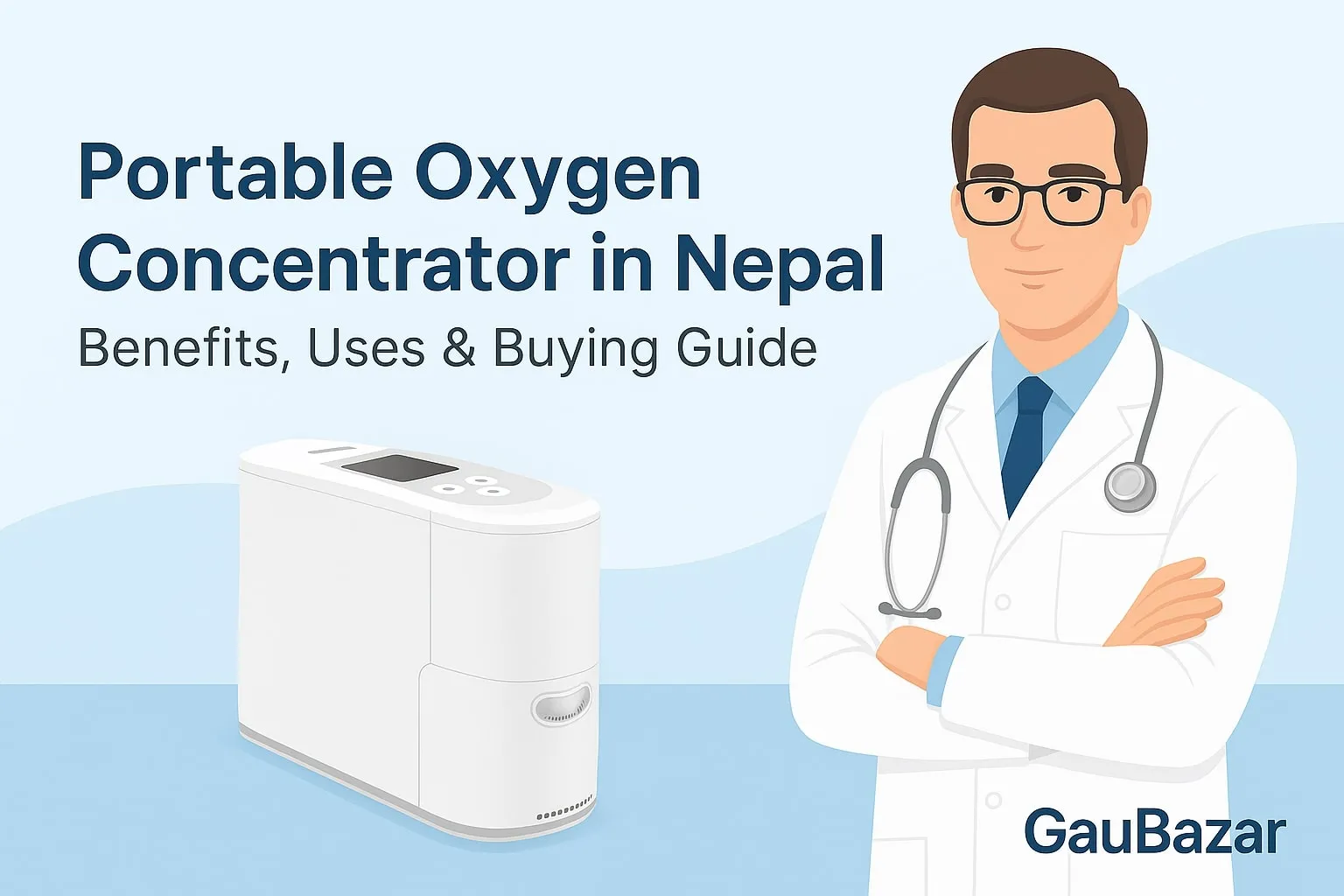
The need for oxygen therapy at home has grown rapidly across Nepal — from post-COVID recovery to chronic respiratory conditions like COPD and asthma. As awareness about home medical equipment increases, many Nepali families are now exploring portable oxygen concentrators as a reliable, mobile solution for oxygen support.
In this guide, we’ll help you understand what a portable oxygen concentrator is, who can benefit from it, and how to choose the right one for your needs in Nepal.

What Is a Portable Oxygen Concentrator?
A portable oxygen concentrator (POC) is a compact medical device that delivers oxygen by filtering it directly from the air around you. Unlike large, stationary oxygen machines, portable concentrators are small, battery-powered, and easy to carry anywhere — at home, outdoors, or even while traveling.
Key Features:
- Lightweight and travel-friendly
- Runs on rechargeable batteries
- Available in pulse-flow or continuous-flow modes
- Eliminates the need for oxygen cylinder refills
💡 In simple words — it gives you oxygen on the move, wherever you are.
Why Portable Oxygen Concentrators Are Gaining Popularity in Nepal
In Nepal’s geography — from the crowded valleys of Kathmandu to the high altitudes of Pokhara or Mustang — accessibility to hospitals and refilling centers can be limited.
Portable oxygen concentrators give patients independence, safety, and peace of mind, especially for home-based care.
Who Should Use a Portable Oxygen Concentrator in Nepal?
Portable oxygen concentrators are ideal for individuals who:
- Need long-term oxygen therapy but want to stay active
- Are recovering from respiratory infections or COVID-19
- Have COPD, asthma, or chronic lung diseases
- Travel frequently and need a lightweight, medical-grade oxygen source
- Live in rural or high-altitude areas where oxygen levels can drop
💡 Doctors in Nepal often recommend portable concentrators for home care patients who want comfort, freedom, and mobility.
How Does a Portable Oxygen Concentrator Work?
Portable oxygen concentrators pull in air, filter out nitrogen, and deliver high-purity oxygen through a nasal cannula.
Most units in Nepal provide 90%–96% oxygen purity, with advanced sensors ensuring stable output.
Typical Process:
- Air intake: The device collects air from the surroundings.
- Filtration: Dust and nitrogen are removed through sieves.
- Concentration: Pure oxygen is stored and sent through tubing.
- Delivery: Oxygen reaches the patient in controlled bursts or steady flow.
Benefits of Using a Portable Oxygen Concentrator
1. Mobility & Freedom
Portable concentrators allow patients to move around freely — go for walks, visit relatives, or travel without worrying about oxygen cylinders.
2. Battery-Powered Convenience
Most devices can run for 4–10 hours on a full charge and can also operate on car or inverter power. This makes them perfect for areas with power cuts — common in many Nepali towns.
3. Lightweight & Easy to Carry
Weighing between 2 kg to 7 kg, these concentrators are easy to transport — many models come with shoulder straps or trolleys.
4. Cost-Effective in the Long Run
Although the initial price is higher than oxygen cylinders, there are no refill costs, making them more economical for long-term use.
5. Safe & Easy to Maintain
No pressurized tanks, no refilling, and low risk of fire or explosion — portable concentrators are safer for home use.
Portable Oxygen Concentrator Price in Nepal
The price of portable oxygen concentrators in Nepal generally ranges between NPR 150,000 to NPR 350,000, depending on:
- Brand (Philips, Oxy-Med, Yuwell, Olive, etc.)
- Oxygen flow rate (1–5 LPM)
- Battery backup duration
- Warranty and service options
For the latest offers and verified models, visit GauBazar.com
Important Considerations Before Buying
When selecting a portable oxygen concentrator in Nepal, always look for:
- Doctor’s prescription (flow rate & duration)
- Oxygen purity of 90% or higher
- Battery life & charging time
- Service availability and warranty support in Nepal
- Durability for Nepal’s climate (humidity, dust, altitude)
💡 Avoid unknown brands or grey-market imports that lack service or spare parts.
Maintenance Tips for Portable Oxygen Concentrators
Keeping your concentrator clean ensures safety and durability.
Follow these steps:
- Clean the air filter weekly with mild soap and water
- Wipe the exterior using a soft, dry cloth
- Store in a dust-free, ventilated area
- Replace tubing and cannulas regularly
- Avoid using the device near flames or heat sources
Read more: Maintenance & Care Tips for Oxygen Concentrator Machines in Nepal
💬 Portable vs Stationary Oxygen Concentrators
Feature | Portable | Stationary |
|---|---|---|
Weight | 2–7 kg | 13–25 kg |
Power Source | Battery + AC | AC only |
Oxygen Flow | Up to 5 LPM | Up to 10 LPM |
Best For | Travel, mobility, short-term use | Continuous home therapy |
Refill Need | None | None |
💡 Many Nepali families use both: a stationary unit at home and a portable one for outdoor use.
Where to Buy Genuine Portable Oxygen Concentrators in Nepal
Finding reliable medical equipment in Nepal can be challenging — that’s why GauBazar partners only with verified suppliers.
At GauBazar.com, you’ll find:
- Certified portable oxygen concentrators from trusted brands
- Transparent pricing and product specifications
- Home delivery across Nepal
- Warranty and after-sales service
Explore all models here:
👉 Portable & Home Oxygen Concentrators in Nepal
Final Thoughts from a Health Educator
A portable oxygen concentrator in Nepal is more than a device — it’s a lifestyle improvement. It gives patients the freedom to breathe, move, and live confidently, without depending on hospital visits or heavy cylinders.
Whether for long-term care, travel, or peace of mind, portable concentrators are a smart investment in health, independence, and safety.
At GauBazar, we believe health education leads to better health decisions — and better lives.
